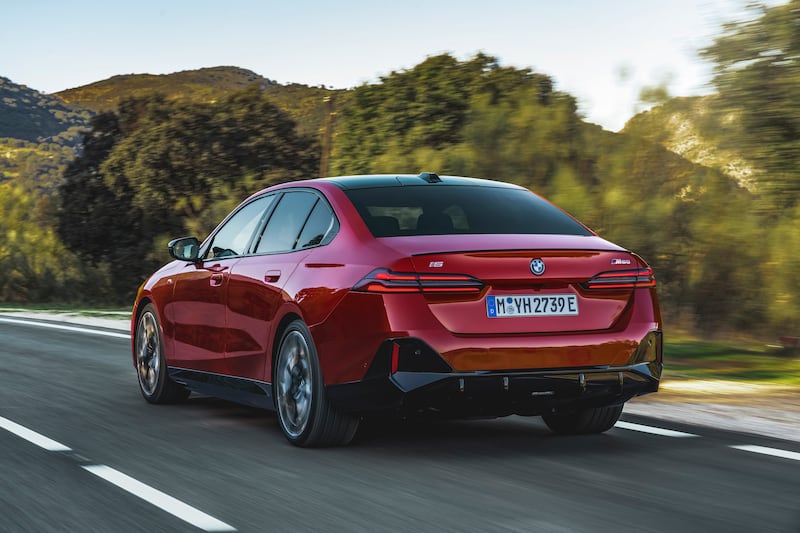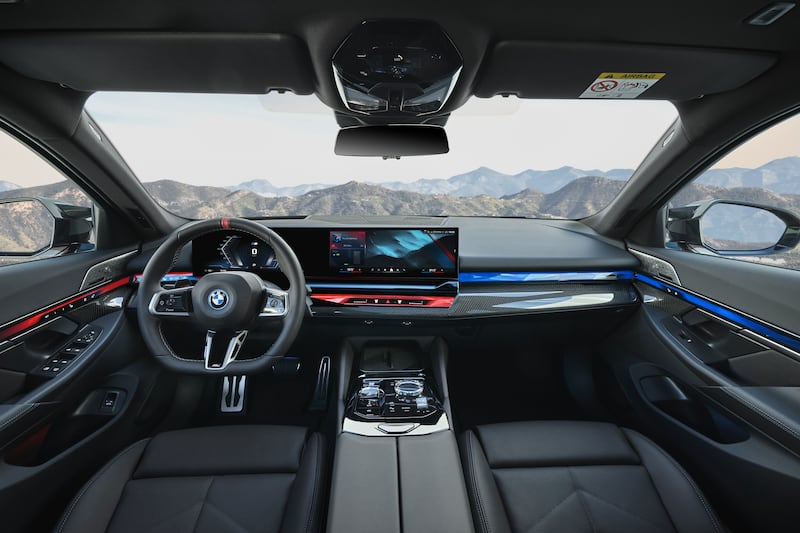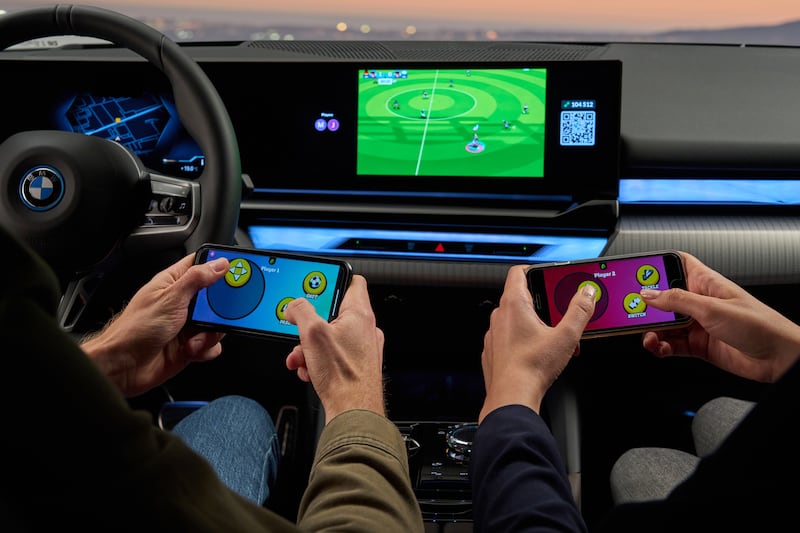There is more than a touch of bling at BMW these days. Whether it’s the menacing grille on a two-tone i7, the technicoloured interior light shows on plastic faux-crystal strips or the cartoonish excess of the iXM, there is nothing subtle about the brand’s styling.
As a lifelong admirer of the 5 Series I feared for the future of its traditional Bavarian sobriety. Thankfully, someone has reined in the excess. True, the new 5 Series offers the option of a surround light on the kidney grilles, but it’s actually quite a nice touch. Tasteful even.
Meanwhile, the silhouette remains distinctively BMW, though the rear of the saloon is more integrated with the slope of the rear window, appearing shorter than the traditional three-box format. In reality the new 5 Series range is bigger than its predecessor; noticeably longer, but also slightly wider and taller. Yet at all times its distinctly BMW, even from a distance.

It’s evolutionary styling is all the more remarkable when set against the revolutionary technology on offer and the innovative turmoil of the new car world as it embraces the electric age.
It’s worth considering the divergent approach taken by the two German arch-rivals in the premium market.
At Mercedes-Benz, the E-Class remains a shining star, but for full-electric you must turn to its new EQE, a distinctly different model.
At BMW, the engineers have sought to offer the same car and driving characteristics regardless of powertrain; whether you opt for diesel, plug-in hybrid or full electric. Sure, the EV version gets a slight name change – i5 – but they are adamant that all iterations should retain the same 5 Series DNA.
That DNA can be hard to define, but in essence it’s about engaging driving dynamics. That’s not to say BMW hasn’t missed the mark a few times, but it has always strived for the same end goal, whether you opt for an entry-level diesel or the dialled-up madcap M version.
A new feature is BMW’s max range function, which the car maker claims can increase the range by up to 25 per cent if required to get you to a charging station
Creating an EV that has similar dynamics to a combustion-engine car is a sweet trick. The physics and distribution of weight are clearly different. Yet BMW seems to have delivered with this i5. It’s all the more impressive given the i5 is a big, heavy beast.
While the 5 Series will be offered in all power flavours, the latest generation will first arrive on the market in all-electric i5 guise, to be followed next spring by plug-in hybrid versions, and then petrol and diesel variants. So EV gets top billing for now. And within the EV range a new i5 M60 xDrive version is the top dog until a new M5 lands next year.
The more mainstream i5 eDrive40 version is rear-wheel drive, as you would expect, and puts out 340hp with torque of 430Nm. It can hit 100km/h from a standing start in six seconds. The battery pack boasts a usable energy capacity of 81.2kWh, delivering a claimed range of 497km-582km. Step up to the M60 xDrive and that range falls to 455km-516km.
A new feature is BMW’s max range function, which the car maker claims can increase the range by up to 25 per cent if required to get you to a charging station, by limiting power and speed while also deactivating comfort functions.
BMW claims that despite it being a bigger car, the new i5 delivers lower energy consumption figures than its recently launched i4 EV coupe. The i5 claims to consume 18.9kWh/100km, compared to 19.1kWh/100km for the i4.
Based on its studies of real-world-driving consumption patterns collected from its EV owners, BMW reckons the i5 should be delivering a figure as low as 15.9kWh/100km to owners. Our time in the car didn’t come close to that, registering a figure of 22kWh/100km, but if owners spent their time in eco mode rather than sport mode, then that figure could be achieved.
[ Are electric cars a bigger fire hazard?Opens in new window ]
Those are the stats, but it’s behind the wheel that this car proves its worth. At Mercedes, the EQE is more about poise and luxury, while BMW has pursued a sportier route. It’s epitomised by the “Boost” lever on the steering wheel. Hit that and it engages Sport mode for 10 seconds, with enough torque to bury your skull in the headrest, along with the requisite rumble of a fighter jet.
Sound is becoming a new playground for EV engineers. It’s an oft forgotten sensory thrill in the motoring world. Ask the owner of a full-throated Ford Mustang or Ferrari what they love about their car and the engine sound will feature high on the list.
BMW used to have its own sweet symphony, courtesy of a tuneful six cylinder. In the age of silent EVs, the big brains at the Bavarian car brand rightly turned to the world of entertainment. At Renault they got Jean-Michel Jarre to create the new soundtrack for its upcoming Scenic and future EVs. At BMW they turned to German composer and Oscar-winning music producer Hans Zimmer. The end result resonates every time you tickle the throttle. In Sports mode, it’s the aural sensation of a fighter jet; in Relax mode each touch of the accelerator delivers a sound reminiscent of a spa retreat.
It might seem silly, but then car makers have been tuning mufflers to deliver the right engine note for years, so why not create a full automotive soundtrack?
It’s not flawless; the i5 does feel heavy through the corners and can get a little giddy when you lay down the throttle on less than perfect surfaces
Set aside the musical score, and the i5 delivers the sort of sharp steering feel and assured ride quality you would expect from a 5 Series. It’s much more engaging than the current array of EVs that have incredible straight-line pace but are stilted when faced with a series of sharp bends.
It’s not flawless; the i5 does feel heavy through the corners and can get a little giddy when you lay down the throttle on less than perfect surfaces. But it’s much more engaging than we have come to expect from big EVs like this. And it’s a welcome reminder as to why saloons and coupes are so much better to drive than SUVs.
If you want the full-throated affect, opt for the M60 version, which mixes neck-snapping acceleration bursts with the added grip of all-wheel drive. But you will not feel shortchanged by the regular i5 eDrive 40.
There’s a plethora of new tech at play on the i5, particularly with the latest advances in assisted steering as we crawl towards full autonomous driving.
When driving on a motorway, the car will monitor inside and outside lanes and if it’s clear and safe to proceed, the driver can direct the car to move into the lane by simply looking into the appropriate wing mirror
Still awaiting approval for use on the Irish market, the latest advance is what BMW calls Highway Assistant. At driving speeds of up to 130km/h, it is possible to take your hands off the steering wheel entirely, as long as you keep a close eye on the traffic. There’s no need to constantly touch the wheel or make minor movements of the wheel every few minutes; the system monitors the driver’s eyes and heads to ensure that they are paying attention.
As an added feature, the system also includes Active Lane Change Assistant with eye confirmation. When driving on a motorway, the car will monitor inside and outside lanes and if it’s clear and safe to proceed, the driver can direct the car to move into the lane by simply looking into the appropriate wing mirror. No need to lift a finger to even hit the indicator; the car does all the signalling, manoeuvring and acceleration or braking required. It’s a brave new world out there, one that may well come to Irish roads in the near future.
Against that backdrop of new tech, the interior’s curved touchscreens and the touch-sensitive control bar that runs across the driver’s cockpit seems pretty mundane.
The touchscreen controls are powered by BMW’s latest software, which is slick and swift, if still too overloaded with superfluous apps. The ongoing pursuit to get occupants to use the BMW screens when waiting in the parked car – rather than turning to their phones – means the car firm has done deals with various content providers.


The end result for German buyers will be the chance to watch highlights of the Bundesliga. Potential deals to show English Premier League highlights is an ambition as well. As for gaming, the system can quickly sync with all occupants’ phones, turning them into controllers for online games and quizzes played on the car’s central screen.
However, as it can’t cast apps like Netflix, many i5 occupants will probably stick with their phones, while in the back, sockets attached to the rear of the front seats for mounting tablet devices signal the game is up for car firm hardware replacing personal mobile devices.
These are all distractions to the main event, however. BMW engineers are eager for its cars to be considered as more than premium-priced motorised smartphones. The driver should take more pleasure from driving than sitting in a car park playing an online version of Who Wants to be a Millionaire?
The good news is that the i5 is sharp to drive. Where the rival Mercedes-Benz EQE leans towards luxury and refinement, the i5 is dialled towards sport, and as a result is more engaging. Just as the styling is an evolution of the 5 Series format, in many ways so is the driving dynamics – only this time the power comes from electricity.
It’s proof that in essence BMW has retained its driving DNA, even if it has a terrible tendency to pimp its cars in far too much bling.











